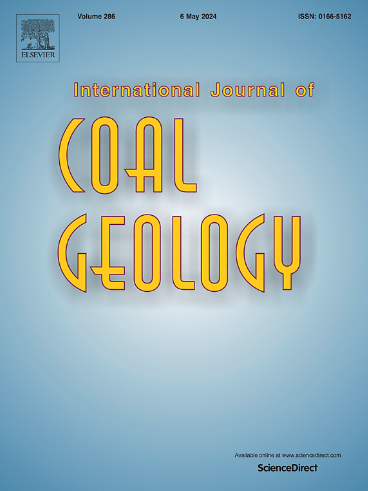micro-Raman indicates biochar has similar stability and structural features as natural fusinite and semifusinite
IF 5.7
2区 工程技术
Q2 ENERGY & FUELS
引用次数: 0
Abstract
Semifusinite and fusinite macerals are formed through carbonization of plant material in naturally occurring wildfires. Both macerals, belonging to the inertinite maceral group, are carbon-rich and oxygen-poor, and are typical constituents of charcoal. The charring of plant material into charcoal is a naturally occurring process that effectively stores carbon over geological timescales. The stability of carbon in biochar formed by pyrolysis of biomass are determined by its degree of carbonization, and long-term storage in soil assumes that the biomass has been completely transformed into inertinite biochar. Inertinite biochar is thought to have a structural composition comparable to highly stable natural fusinite, whereas less carbonized biochar is similar to less stable semifusinite. In this study, micro-Raman spectroscopy was employed to examine the structural composition of 16 biochar samples produced at different temperatures from various lignocellulosic feedstocks, as well as one natural semifusinite isolated from a coal deposit. The estimated carbonization temperatures, representing the actual internal heating temperatures experienced by the biomass, ranged from 326 to 825 °C. The micro-Raman results of the biochar samples were compared with previously published micro-Raman data on naturally formed semifusinite and fusinite. The findings show that biochar, semifusinite, and fusinite likely undergo similar structural evolution with increasing temperatures, suggesting that the process of pyrolyzing biomass into biochar may mimic the natural charring process that occurs during wildfires. Though additional work could help to validate benchmarks, these results support the idea that biochar stability is similar to that of fusinite and semifusinite and indicate its potential as a long-term storage solution in the context of the geological carbon cycle. Furthermore, the results indicate that in addition to the established inertinite benchmark (IBRo2%; Ro = 2 %) for determining biochar stability, up to four new micro-Raman benchmarks can be used to define inertinite biochar: (1) D3-band position: 1460 cm‐1 or higher, (2) D1/G amplitude ratio: 0.80 or higher, (3) Raman band separation (RBS): 250 cm‐1 or higher, and possibly (4) G-FWHM (full width at half maximum): 72 cm‐1 or lower. The availability of multiple benchmarks that can indicate biochar stability could provide tools for evaluating biochar long-term storage potential, thus reinforcing carbon dioxide removal (CDR) via biomass waste pyrolysis as a viable technique to mitigate climate change.
微拉曼表明生物炭具有与天然云母岩和半云母岩相似的稳定性和结构特征
半绢云石和绢云石矿物是在自然发生的野火中通过植物材料的炭化而形成的。这两种显微组分均属于惰质显微组分,富碳贫氧,是木炭的典型成分。将植物材料炭化成木炭是一种自然发生的过程,可以有效地在地质时间尺度上储存碳。生物质热解形成的生物炭中碳的稳定性取决于其炭化程度,长期储存在土壤中假设生物质已经完全转化为惰质生物炭。惯性质生物炭被认为具有与高度稳定的天然云母质相当的结构组成,而较少碳化的生物炭类似于不太稳定的半云母质。在这项研究中,利用微拉曼光谱分析了在不同温度下由不同木质纤维素原料生产的16种生物炭样品的结构组成,以及从煤层中分离出来的一种天然半绢云石。估计的炭化温度,代表生物质经历的实际内部加热温度,范围为326至825°C。生物炭样品的微拉曼结果与先前发表的自然形成的半云母和云母的微拉曼数据进行了比较。研究结果表明,随着温度的升高,生物炭、半云母石和云母石可能经历了相似的结构演变,这表明生物质热解成生物炭的过程可能模拟了野火中发生的自然炭化过程。尽管进一步的工作可能有助于验证基准,但这些结果支持了生物炭的稳定性与云母岩和半云母岩相似的观点,并表明其在地质碳循环背景下作为长期储存解决方案的潜力。此外,结果表明,除了建立的惯性基准(IBRo2%;Ro = 2%)用于确定生物炭的稳定性,多达四个新的微拉曼基准可用于定义惯性质生物炭:(1)d3波段位置:1460 cm‐1或更高,(2)D1/G振幅比:0.80或更高,(3)拉曼波段分离(RBS): 250 cm‐1或更高,并且可能(4)G- fwhm(最大一半的全宽度):72 cm‐1或更低。可以表明生物炭稳定性的多个基准的可用性可以为评估生物炭的长期储存潜力提供工具,从而加强通过生物质废物热解去除二氧化碳(CDR)作为缓解气候变化的可行技术。
本文章由计算机程序翻译,如有差异,请以英文原文为准。
求助全文
约1分钟内获得全文
求助全文
来源期刊

International Journal of Coal Geology
工程技术-地球科学综合
CiteScore
11.00
自引率
14.30%
发文量
145
审稿时长
38 days
期刊介绍:
The International Journal of Coal Geology deals with fundamental and applied aspects of the geology and petrology of coal, oil/gas source rocks and shale gas resources. The journal aims to advance the exploration, exploitation and utilization of these resources, and to stimulate environmental awareness as well as advancement of engineering for effective resource management.
 求助内容:
求助内容: 应助结果提醒方式:
应助结果提醒方式:


